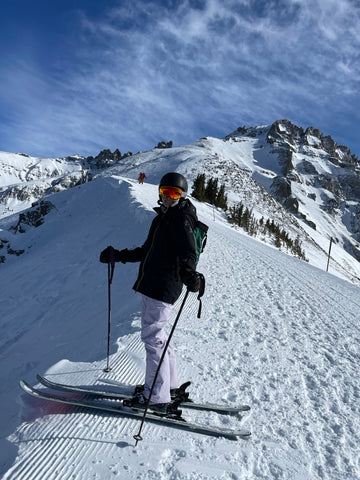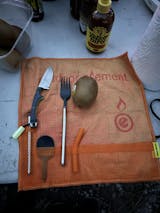Backpack Breakdown: An Incomplete Guide to Help You Stay Prepared for Anything
Outdoor Elementwritten by OE Athlete Kora Heintz
 I have a few rope-drops behind me as well as a few core shots and this season is shaping up to be a wild one already. It has reminded me why it's important to be ready for anything and everything, which is why I use a backpack to help me stay prepared.
I have a few rope-drops behind me as well as a few core shots and this season is shaping up to be a wild one already. It has reminded me why it's important to be ready for anything and everything, which is why I use a backpack to help me stay prepared.
For starters, I organize my backpack by three categories: daily gear, the backups, and food. I use a Slackpack 2.0 from The North Face to carry all of my gear. This is a great backpack for skiers and snowboarders who are going on more extreme terrain and even hiking because of its flat back, extra straps, and lean shape. It also can be used in the backcountry. I’ve also used a Fusebox in the past which works great for cold temperatures. There are many other great bags out there, finding the right one can take a little research but it's 100% worth it in the long run.
My Slackpack 2.0 with helmet attached.

My daily gear can vary based on what resort I’m at and the conditions. The most consistent items are goggle lens, oxygen/inhaler, rub-on wax, carabiners, and hand warmers. I keep multiple lenses with me and I highly recommend this for anyone spending the whole day on the hill. It saves you a car trip at lunch when the weather app lies and your bluebird day turns out to be more overcast.
My main ski areas are Copper Mountain (Frisco, CO) and ABasin (Arapahoe Basin, Dillon, CO) where there is a ton of above-tree-line skiing. If the trees can’t breathe it's no surprise that you might struggle too, making oxygen a smart addition to even your pocket if you're not carrying a pack. Hand warmers are a no-brainer no matter where you're skiing. Rub-on wax is a nice piece of gear to stick in your bag if you're getting the full worth out of your season pass and don’t have the time to wait 2 weeks to get your skis or board waxed.
I have anywhere between 2-8 carabiners on my pack. One of them is a Fire Escape that holds my keys and a Swiss army knife. I use the little blade on the Fire Escape to cut open stubborn chip bags when my fingers are numb and don’t know what I would do without it. I also have quite a few Gearbiners in/on my bag. These carabiners are great for keeping my helmet and boots attached to my bag.


Gearbiner keeping my boots on my bag
Switching gears a little bit, I highly recommend a first aid kit as well. My favorite addition to any kit is medical tape that doubles as a support for shin bang or a fix for that hole in your glove. These items can change from day to day, for example, I bring Apres Ski Vans when I’m at Copper to make riding the bus a little more bearable or I might leave my back protector in my bag if I'm skiing with friends. Your daily items are probably a little bit different from mine, but it's important that they make you confident that you can face anything.

It’s no lie that gear isn't perfect and malfunctions happen, that's where backup gear comes into play. These items stay in the bottom of my bag until they either expire or I have an emergency. One good habit to form around skiing is checking your gear at the start of every season. If it's expired or out of date, get rid of it. My most important backups are gloves, buff, and socks. Gloves get holes too easily making an extra pair essential. A fresh buff at lunch on a snowy day can be the best feeling in the world. I switch out my buff at lunch so often it's almost a daily item at this point. Socks feel like the same type of no-brainer as hand warmers. Some other items to consider are a charging block and cord, lotion, vaseline, and sunblock.
I won’t go into much depth about the food part of my bag but if you need inspo for snacks or lunch for the hill there are many great and easy recipes on Pinterest. A sac lunch is a great way to save a little money and I am an advocate for a good ol’ turkey and cheese sandwich. There’s nothing like soup on a cold day, which in that case I put an Omni-Tensil spoon in my bag. Don’t forget to bring plenty of snacks and water.
Because I don’t ski with my pack, some items that could be carried in one I carry in my jacket instead. I keep a few snacks on me at all times, they’re great for when the lift stops. While it's not for everyone, I love to ski to music so I often keep earbuds in my breast pocket with my phone. Sometimes things happen and I get separated from my group or vice versa and someone gets lost from me. In both scenarios having a Wombat Whistle to let people know my location is super helpful. It also can scare off wildlife. I also never adventure without my Kodiak Bracelet. All of these items can be carried on your person or in a pack. Regardless they’re good to have on the slopes.
I want to emphasize that it's your pack! These items work for me but might not work for everyone. Just like the backpack I use won’t work for everyone. Sometimes all you need is a fanny pack to hold your snacks and water and that is perfect for you. Also, I mainly ski resorts because that's where I compete so this probably isn’t a great list if you're planning on going touring.
Skiing and snowboarding is unique to each individual and your pack should also be unique. Stay safe and confident on the slopes!


Me wearing my backpack before hitting the slopes and a display of all the items/gear I keep in my bag.
Ski lingo translator:
Rope Drop- When ski patrol opens up a new area, dropping the rope marking it closed.
Core Shot- When a rock scrapes your ski bases and it shows the core.
Freerider- Someone who participates in freeride, a division of competitive skiing
Shin Bang- An injury common among skiers and boarders that causes extreme pain in the front and side of the shin.
Touring- Another name for backcountry skiing
Notable Gear:

